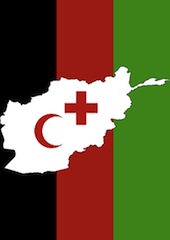Why Aid Workers Are Targets
What happens to global development when humanitarian aid becomes a central component of military strategy?
May 14, 2013

At last count, 45 humanitarian aid workers have been killed, wounded or kidnapped in Afghanistan so far this year, for a total of over 680 since the conflict began in 2001.
This number does not include civilian reconstruction workers working on government or military contracts.
It includes only the nonprofit, nongovernmental organizations that are in the country to provide neutral and impartial assistance to Afghans affected by conflict and crushing poverty.
Despite their apolitical status, aid agencies have been repeatedly targeted for deliberate violence by the armed opposition in Afghanistan. That country has seen far higher numbers of attacks on aid workers than anywhere else in the world.
Since the beginning of the U.S.-led campaign, attacks on aid workers, while at a lower level, have followed a roughly similar trend pattern to U.S. military fatalities.
They even show the same bump in 2010, as attacks increased during the U.S. troop “surge,” even though there was no commensurate surge in humanitarian aid agency personnel.
Aid worker attacks in Afghanistan compared with US troop fatalities
![]()

Sources: iCasualties.org and Humanitarian Outcomes
Providing aid in conflict zones has always been a dangerous business. Aid workers are not only soft targets. They also have valuable assets that can be expropriated or diverted for strategic purposes.
For as long as there have been humanitarian workers, they have lamented the “blurring of the lines” and the “shrinking humanitarian space” when militaries become too closely involved or associated with aid efforts.
But the Afghanistan conflict represents something different and far more extreme in its implications for aid work.
In fact, the nature of counterinsurgency operations there makes neutral humanitarian assistance almost impossible.
The U.S. forces in Afghanistan, for as long as they remain, are employing counterinsurgency strategy (“COIN” in U.S. military parlance), an approach that is uniquely threatening to traditional humanitarian action.
Although it took four years of horrendous failure in Iraq and a determined cadre of well-placed strategists (among them David Petraeus) to help push it through, COIN is now prominent in U.S. military doctrine.
The military sees it as an essential toolkit for addressing the threats to U.S. security interests in the post-9/11 world.
Counterinsurgency is an indirect form of warfare that is more political than military in its tactics — more “hearts and minds” than “shock and awe.”
Its main focus is not on killing the enemy, whose forces can easily disperse and regroup ad infinitum, but on the local population.
By offering protection and aid to communities, the COIN logic goes, you will isolate the insurgents and ultimately enlist the population’s help in rooting them out.
The US 2006 Counter Insurgency Field Manual states it plainly:
“At its core, COIN is a struggle for the population’s support. The protection, welfare and support of the people are vital to success…Political, social, and economic programs are usually more valuable than conventional military operations…COIN participants…may include military personnel, diplomats, police, politicians, humanitarian aid workers, contractors and local leaders.”
In COIN, in other words, humanitarian aid is not something that the military allows “space” for. Rather, it is a central component of military strategy.
This can be achieved whether the military provides aid itself, as the Provincial Reconstruction Teams (PRTs) do in Afghanistan, or merely by the presence of aid agencies doing their thing.
This is a particular problem for traditional, “Dunantist” agencies, whose ideology and approach was born of a very different sort of war.
Red Cross Founder Henry Dunant’s vision of inter-arma caritas was conceived to apply to wars between nations. It takes war as a given, if regrettable, state of human affairs and advances a set of rules and boundaries to minimize the harm to civilians.
While states’ armies battle each other, independent humanitarian agencies, protected by their neutral status, can work to protect and aid the population.
The model never translated very easily into the following century’s increasingly common scenario of civil conflicts within states.
However, by adhering to the principles of neutrality, impartiality and independence and negotiating their way in, humanitarians found they could secure safe access to work.
In violent counterinsurgency contexts, though, this becomes an almost impossible proposition.
The insurgent’s goal becomes to disrupt and delegitimize the stabilization attempts around local populations. In his eyes, all aid efforts that support the goals of the government or the foreign occupying forces is a genuine threat and legitimate target.
Although analysis by the Afghanistan NGO Safety Office suggests that some armed opposition forces do discriminate among aid providers to suit particular local objectives, at a national level there is no need for them to distinguish between aid that comes from U.S. military forces or contractors and aid from nongovernmental agencies.
From their perspective, it is all of a piece (plus, the NGOs are easier to hit).
The humanitarian dilemma
As violence in Afghanistan has increased over the past ten years, humanitarians have reduced their presence. Many agencies withdrew staff to provincial capitals and others withdrew altogether.
With such a limited operational reach, it is unconscionable (as well as pointless) for aid agencies to call on coalition forces to refrain from providing direct aid to Afghans who desperately need it.
At the same time, those that remain in the country trying to work, such as the ICRC, face growing risks and obstacles to reaching these populations.
Humanitarian agencies are left with a rotten choice: pull out and abandon the few people you are able to help, or stay and contend with increasing insecurity and futility.
Time and politics might settle the question for them. To do counterinsurgency properly requires a military to remain in place, along with sizable civilian deployments, for a very long time.
As T.E. Lawrence famously wrote, the process is “messy and slow, like eating soup with a knife.”
After the scarring experience of Vietnam and now over ten years in Afghanistan, the United States has a limited appetite for it. As the last U.S. forces withdraw from Afghanistan in 2014, the operational landscape for humanitarian workers may change.
Tragically, the humanitarian needs are likely to be the constant.
Takeaways
Read previous

The United States: A Very Uneven Recovery
May 13, 2013
